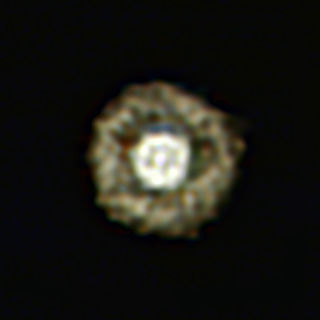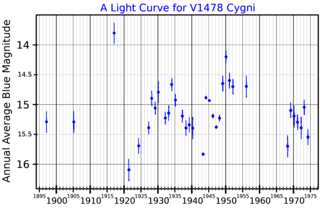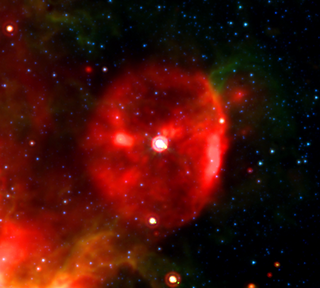
40 Eridani is a triple star system in the constellation of Eridanus, abbreviated 40 Eri. It has the Bayer designation Omicron2 Eridani, which is Latinized from ο2 Eridani and abbreviated Omicron2 Eri or ο2 Eri. Based on parallax measurements taken by the Gaia mission, it is about 16.3 light-years from the Sun.

The Horsehead Nebula is a small dark nebula in the constellation Orion. The nebula is located just to the south of Alnitak, the easternmost star of Orion's Belt, and is part of the much larger Orion molecular cloud complex. It appears within the southern region of the dense dust cloud known as Lynds 1630, along the edge of the much larger, active star-forming H II region called IC 434.

In astronomy, Bok globules are isolated and relatively small dark nebulae, containing dense cosmic dust and gas from which star formation may take place. Bok globules are found within H II regions, and typically have a mass of about 2 to 50 solar masses contained within a region about a light year or so across (about 4.5×1047 m3). They contain molecular hydrogen (H2), carbon oxides and helium, and around 1% (by mass) silicate dust. Bok globules most commonly result in the formation of double- or multiple-star systems.

Sh2-279 is an HII region and bright nebulae that includes a reflection nebula located in the constellation Orion. It is the northernmost part of the asterism known as Orion's Sword, lying 0.6° north of the Orion Nebula. The reflection nebula embedded in Sh2-279 is popularly known as the Running Man Nebula.

Phi Cassiopeiae is a multiple star in the constellation Cassiopeia with a combined apparent magnitude of +4.95. The two brightest components are A and C, sometimes called φ1 and φ2 Cas. φ Cas A is an F0 bright supergiant of magnitude 4.95 and φ Cas C is a 7.08 magnitude B6 supergiant at 134".

Sakurai's Object is a star in the constellation of Sagittarius. It is thought to have previously been a white dwarf that, as a result of a very late thermal pulse, swelled and became a red giant. It is located at the center of a planetary nebula and is believed to currently be in thermal instability and within its final shell helium flash phase.

AO Cassiopeiae, also known as Pearce's Star, is a binary system composed of an O8 main sequence star and an O9.2 bright giant that respectively weigh anywhere between 20.30 and 57.75 times and 14.8 and 31.73 times the mass of the Sun.

HD 165516 is a blue supergiant star in the constellation Sagittarius. It is part of the Sagittarius OB1 association and appears against a rich Milky Way starfield near the Triffid Nebula and Lagoon Nebula.

IRAS 17163−3907, also known as Hen 3-1379, is a yellow hypergiant star located 13,000 light years from Earth in the constellation of Scorpius. The star is embedded in thick shells of expelled gases and dust, and owing to its appearance has been nicknamed by astronomers the "Fried Egg Nebula". Yellow hypergiants are in an extremely active phase of their evolution.

MWC 349 is a double star system in the constellation Cygnus. Its properties are still debated and it may be a massive highly luminous star or a very young less luminous Herbig Ae/Be star. MWC 349 is also a variable star with the designation V1478 Cygni.

IRC+10420, also known as V1302 Aql, is a yellow hypergiant star located in the constellation of Aquila at a distance of 4-6 kiloparsecs of the Sun.

HD 168625 is a blue hypergiant star and candidate luminous blue variable located in the constellation of Sagittarius easy to see with amateur telescopes. It forms a visual pair with the also blue hypergiant HD 168607 and is located to the south-east of M17, the Omega Nebula.

AE Andromedae is a luminous blue variable (LBV), a type of variable star. The star is one of the most luminous variables in M31, the Andromeda Galaxy.

HD 179821 or V1427 Aquilae is either a post-red supergiant yellow hypergiant or a post-AGB yellow supergiant star in the constellation of Aquila, surrounded by a detached dust shell. It is a semi-regular variable nearing the end of its life.

42 Orionis is a class B1V star in the constellation Orion. Its apparent magnitude is 4.59 and it is approximately 900 light years away based on parallax.

HDE 316285 is a blue supergiant star in the constellation Sagittarius. It is a candidate luminous blue variable and lies about 6,000 light years away in the direction of the Galactic Center.

V4650 Sagittarii (qF362) is a luminous blue variable star (LBV) in the constellation of Sagittarius. Located some 25,000 light years away, the star is positioned on the edge of a starburst cluster known as the Quintuplet cluster.
















